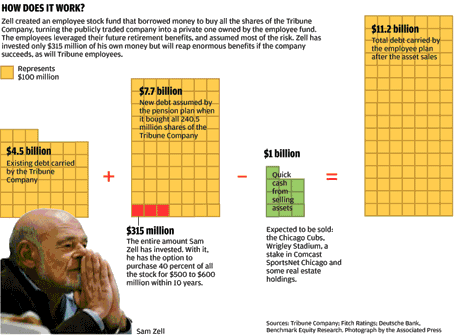Sign up for the daily CJR newsletter.
As far as voices of support go, the news business probably wishes it could do better than a patent troll . But I suppose it’ll take what it can get these days.
Unfortunately, Nathan Myhrvold, writing for Bloomberg View, gets a couple of pretty big things wrong in describing the woes of the newspaper business.
For instance, in discussing them, he says this about why papers have gone bust:
In the past few years, major papers have gone bankrupt in Philadelphia, Minneapolis and other cities, as circulation and advertising revenue have plummeted.
This sentence isn’t wrong per se, but it’s incomplete enough to be misleading. It’s obviously true that circulation and advertising revenue have plummeted at those papers and just about everywhere else, contributing to their ill health. But the real reason the Philly and Minneapolis papers went bankrupt is because their owners loaded them up with debt to purchase them. These were private-equity deals. Their acquirers Mitt Romney’d the companies.
Philadelphia Media Holdings put $412 million of debt on the Inquirer and Daily News. Even at the time of bankruptcy, the papers were kicking off $36 million in ebitda. Private equity firm Avista Capital Partners bought the Star Tribune in 2006 for $530 million, $436 million of which was debt piled on to the paper. In 2009, when it went bankruptcy, the Strib still had $21 million of ebitda.
The biggest bankruptcy, of course, was Tribune Company, which was also a private-equity flop led by real estate cowboy Sam Zell, who saddled the company with $8 billion in plainly unaffordable new debt:
Had they not been put in major hock by private-equity investors playing with other people’s money just before the deepest recession in eighty years, these newspapers probably wouldn’t have needed restructuring—not yet anyway. That’s not to minimize the operating troubles these companies have. It’s just getting the proximate cause of their bankruptcies correct.
Myhrvold also says this:
A few newspapers — the Economist, the Wall Street Journal, the New York Times — have started selling digital-only subscriptions. It’s a first step, but they still plainly consider their print editions to be the gold standard, so they generate little unique digital content and fail to tap the full potential of online news.
While no one’s going to argue that anyone is “tapping the full potential of online news,” it’s just not true that these publications don’t put out much digital-first content.
Here’s the blog directory for The New York Times. I count sixty-two different ones, from The Local East Village to India Ink to On the Runway.
The Wall Street Journal has fifty-three blogs, from Speakeasy to Real Time Economics to Corruption Currents (“Commentary and news about money laundering, bribery, terrorism finance and sanctions”).
The Economist has twenty-three blogs, from Babbage to Free Exchange to Prospero.
It’s worth noting that the Times has its own digital R&D lab too.
It’s nice that a tech guy like Myhrvold thinks people will pay for high-quality news. Perhaps that’s because his day job makes him partial to toll booths.
But if we’re going to talk about the future of this industry, we’d better get the past and the present right first.
Has America ever needed a media defender more than now? Help us by joining CJR today.







